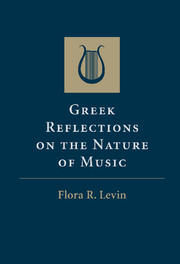Book contents
- Frontmatter
- Contents
- Figures
- Preface
- Introduction
- Abbreviations
- Texts
- 1 All Deep Things Are Song
- 2 We Are All Aristoxenians
- 3 The Discrete and the Continuous
- 4 Magnitudes and Multitudes
- 5 The Topology of Melody
- 6 Aristoxenus of Tarentum and Ptolemaïs of Cyrene
- 7 Aisthēsis and Logos: A Single Continent
- 8 The Infinite and the Infinitesimal
- ΣΦPAΓIΣ
- Bibliography
- Index
1 - All Deep Things Are Song
Published online by Cambridge University Press: 21 October 2009
- Frontmatter
- Contents
- Figures
- Preface
- Introduction
- Abbreviations
- Texts
- 1 All Deep Things Are Song
- 2 We Are All Aristoxenians
- 3 The Discrete and the Continuous
- 4 Magnitudes and Multitudes
- 5 The Topology of Melody
- 6 Aristoxenus of Tarentum and Ptolemaïs of Cyrene
- 7 Aisthēsis and Logos: A Single Continent
- 8 The Infinite and the Infinitesimal
- ΣΦPAΓIΣ
- Bibliography
- Index
Summary
This world is not conclusion;
A sequel stands beyond,
Invisible, as music,
But positive, as sound.
Emily Dickinsonit is now above seventeen hundred years since bacchius the Elder (as he was then called), a Greek writer on music, opened his Introduction to the Art of Music with the seemingly artless question: “What is music?” The answer given by Bacchius to that question illustrates wonderfully the ancient Greeks' passion for logic: “It is a conceptual knowledge of melody and all that pertains to melody.” There is in Bacchius' answer a dynamic reciprocity: melody provides the conditions for music's existence, while music at the same time subsists by virtue of melody. After detailing all the elements that pertain to melody – pitch, interval, consonance, dissonance, scales, modes, modulation, keys, rhythm, and much more – Bacchius arrived at not one but two different definitions of melody. The first is deliberately circular: “It is the fall and rise generated by melodious notes.” Such a definition is tantamount to asserting that something is a melody because its constituents are melodious. If Bacchius' definition is in fact tautological, it seems to be so consciously, in order that it be correct on purely musical grounds. It arises from Bacchius' belief that nothing in the world outside of melody can be invoked or enlisted to define anything that lies within the precincts of melody. Bacchius' approach to the nature of melody adumbrates almost eerily what Ludwig Wittgenstein was to observe centuries later: “Die Melodie ist eine Art Tautologie, sie ist in sich selbst abgeschlossen; sie befriedigt sich selbst. [Melody is a form of tautology, it is complete in itself; it satisfies itself.]”
- Type
- Chapter
- Information
- Greek Reflections on the Nature of Music , pp. 1 - 47Publisher: Cambridge University PressPrint publication year: 2009

